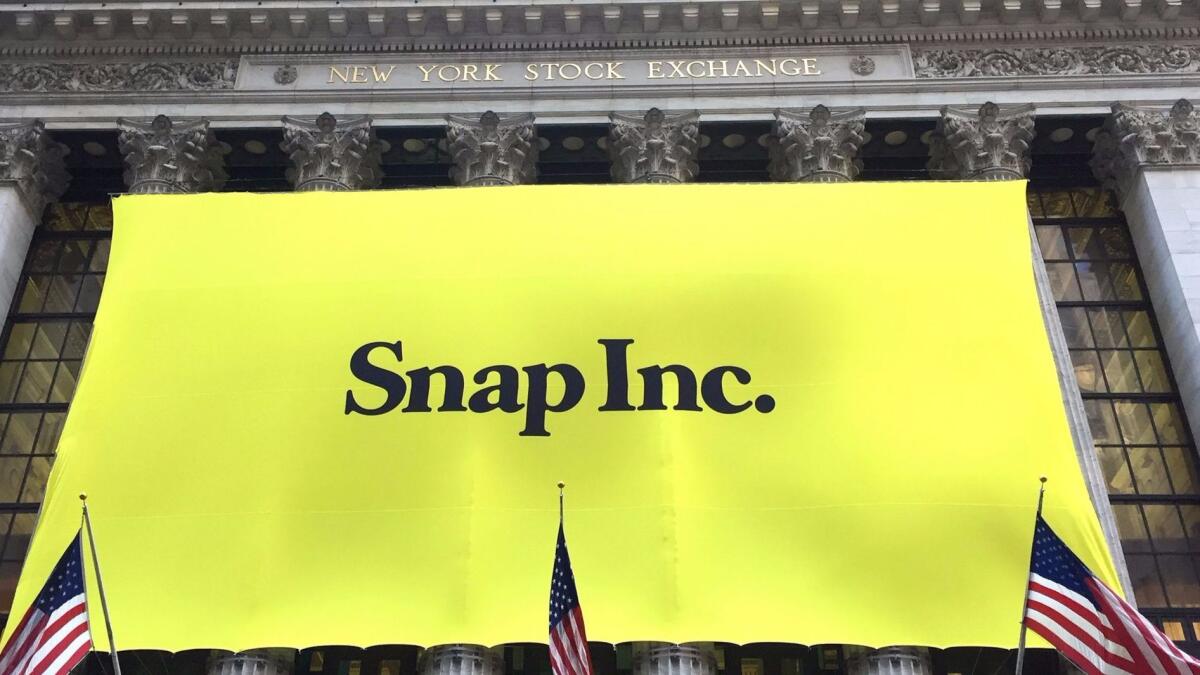Snapchat maker’s IPO has its unlikely winners and frustrated losers

The students at Saint Francis High School in Mountain View were presented with an unique math problem this week: How do you turn $15,000 into $24 million and then some?
The answer: Invest in Snapchat.
The Catholic school in the heart of Silicon Valley is celebrating a windfall from the initial public offering and stock market debut Thursday of the popular photo and video messaging app. One of the school’s students is the daughter of Barry Eggers, founder of Lightspeed Venture Partners, Snapchat’s first investor. Eggers urged the school to place a small bet on the fledgling Venice company, which is now called Snap Inc., after he saw how engrossed his children were with the app. When Saint Francis sold two-thirds of its shares at $17 apiece, it reaped a massive return on investment.
“Saint Francis has been blessed to have parents who so passionately and generously share their gifts with the school,” high school President Simon Chiu said in a letter to the school community. “These are exciting and humbling times.”
As the dust settles from Snap’s highly anticipated $3.4-billion stock debut, a clearer picture is emerging of the winners and losers. Saint Francis is firmly among the former, pledging to use the money to boost financial aid and improve campus facilities. Its unexpected return follows in the tradition of unlikely winners in stock IPOs, like the chef and masseuse who came away with millions after Google went public in 2007.
Those examples are few and far between, however. Most of Snap’s biggest gainers were the obvious ones. Founders Bobby Murphy and Evan Spiegel each made $272 million by selling shares Thursday. They also made more than $1 billion in paper gains as stocks soared on the first day of trading and rose an additional 10% on Friday to close at $27.09.
San Francisco venture capital firm Benchmark unloaded the most valuable chunk of Snap shares as part of the IPO, worth $340 million. Gains among other venture capital firms include $147 million for Eggers’ Lightspeed Venture Partners, $18 million for General Catalyst and $3 million for SV Angel. Snap Chairman Michael Lynton sold about $2 million worth of shares.
Hundreds of Snap’s rank and file could soon become millionaires too after rules lift allowing them to cash out (Snap declined to comment on whether its contractors and support staff, such as shuttle drivers, security guards and cafeteria workers, received stock or bonuses tied to the IPO). That has wealth management firms salivating as they hope to turn these suddenly wealthy workers into clients.
Ross Gerber, chief executive of Santa Monica wealth management firm Gerber Kawasaki, said his firm is putting together ad campaigns on Facebook, Twitter and Instagram aimed at Snap employees. Gerber’s office is in Santa Monica Business Park, the same development where Snap recently leased 300,000 square feet of office space.
“Whenever companies have big liquidity events, we target employees, send them ads and say, ‘Come get help,’ ” Gerber said.
But for every beneficiary of the Snap debut are more than a handful of frustrated losers — sore from kicking themselves for passing on a company bound for the biggest IPO since Alibaba raised $25 billion in 2014.
Among the most regretful examples is celebrity investor Chris Sacca, who on Thursday tweeted a screenshot of a 2012 email from Murphy asking for a meeting.
“I know one person who isn’t getting rich in the Snapchat IPO,” Sacca wrote. “Hint: the guy who didn’t reply to this email. Congrats to everyone at $SNAP!”
(Don’t break out the Kleenex just yet for Sacca. He’s still got $1.2 billion, according to Forbes.)
Also missing out? Every major Los Angeles-based venture capital firm, including Upfront Ventures, which dismissed Snapchat as a sexting tool, and CrossCut Ventures and Clearstone Venture Partners, which didn’t have enough free cash to get in on Snapchat.
“You’d have to be an idiot to say I’m not bummed,” Upfront Ventures’ managing partner Mark Suster told The Times last month.
Actor Ashton Kutcher, a prolific tech investor whose holdings include Airbnb and Uber, recalled last year that he rejected opportunities to invest in an early version of Snapchat after meeting Spiegel because he felt the app looked terrible and would run into too many security concerns.
His investment partner at the time, Chris Hollod, is at peace with the missed opportunity, saying people took for granted “how innovative and disruptive” companies such as Snapchat were at their start.
“It was just one of many social media apps popping up,” rather than a “no-brainer” then, Hollod said. “But I don’t take missing out as a diss. I’m 34 years old. Sometimes we have to put faith in the younger generation and just trust the data. To that high school, Snapchat must have felt intuitive.”
Some investors had to try more than once to get a piece of Snap. Spiegel rejected an investment offer from the New York hedge fund Coatue Management in early 2013, according to an account in Fortune at the time. But he changed his mind by year’s end, taking $50 million from Coatue after spurning talks with Chinese tech giant Tencent. Coatue didn’t respond to a request for comment.
As is often the case in investing, a big payout isn’t just the result of luck, but also an appetite for risk and some knowledge of the market.
In Saint Francis’ case, there were all three.
The school has been investing in start-ups since 1990 through a growth fund created at the suggestion of two venture capitalist parents. The fund held on to a third of its Snap shares, which could prove to be even more valuable.
Though Snap’s success will go toward financial aid, facilities and new teachers at the school, it so far hasn’t led to a more permissive attitude about use of the company’s app. The school has a no-phone policy during class, lunchtime and break time, said Holly Elkins, the school’s executive director of institutional advancement said.
“We want students to socialize and enjoy each other,” she said.
Times staff writers Nina Agrawal and James Rufus Koren contributed to this report.
Follow @dhpierson and @peard33 on Twitter
More to Read
Inside the business of entertainment
The Wide Shot brings you news, analysis and insights on everything from streaming wars to production — and what it all means for the future.
You may occasionally receive promotional content from the Los Angeles Times.












